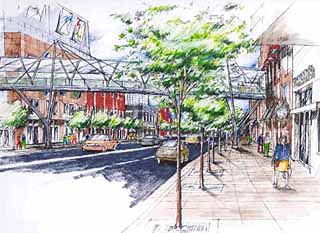
Surveys
DJC.COM
December 9, 2004
Let's go downtown — Bellevue, that is
Journal Staff Reporter

Rendering courtesy city of Bellevue
To make downtown more pedestrian friendly, Bellevue plans to allow a skybridge over Bellevue Way to connect Lincoln Square with Bellevue Square.
|
If growth management proponents are looking for a success story, they'll find plenty to talk about in downtown Bellevue.
These days, King County's "second city" is playing second fiddle to no one when it comes to development. Crews are working on myriad projects, including Lincoln Square, which at 1.4 million square feet is among the largest mixed-use projects under construction in the country.
Residential projects, such as Su Development's 23-story Ashwood Commons, are under way. Even in the less healthy office sector there is activity; Bentall Capital is expanding The Summit for Puget Sound Energy.
The list doesn't stop there. A new City Hall. The planned expansion of Overlake Hospital and related extension of Northeast 10th Street across Interstate 405. Schnitzer Northwest and Wasatch Property Management's massive mixed-use projects.
"There's so many it's hard to keep track of," said Mayor Connie Marshall, remembering the days not too many years ago when the city was a sleepy bedroom community. Back then, when people talked about going downtown, they weren't referring to Bellevue. "It used to be when you went out for dinner, you went downtown and that was Seattle."
All the development is occurring in or around Bellevue's tiny downtown, which measures only about two-thirds of a square mile. City Planning Director Dan Stroh estimated that 75 percent of the growth in Bellevue will be funneled downtown.
Those who wrote the state's Growth Management Act, which the Legislature enacted almost 15 years ago, would be proud. Concentrating growth in compact areas to combat sprawl is a key tenet of the landmark law.
But Bellevue was ahead of the curve, recalled Brian Brand, who moved to the city in 1970. Brand is a principal at Baylis Architects in Bellevue and monitored the growth.
Long before the term "growth management" entered the vernacular of Olympia, he said development pressures began increasing. In the late-1970s, he recalled how Bellevue officials hired consultants to help them plan a central business district that would have higher densities and a mix of uses. That was the foundation for future plans.
It was slow going at first. True, the city has experienced several building booms over the years. But the thought of Bellevue as a 24-hour city, or even an 18-hour one, was laughable. Outside of the 1.3 million-square-foot Bellevue Square mall and a handful of office towers that stuck up like gangly things, there wasn't much there.
Now the city is putting some meat on its bones. For proof, look at the number of downtown residences.
"We had around 650 housing units (downtown) in 1999," said Stroh. "Currently, it's about 3,200 with another 400-some under construction and 950 in the pipeline." The city forecast is 14,000 people will live downtown by 2020.
That kind of density is what counts. More people fuel more activity. More activity, such as cultural events, brings more people and drives demand for transit, which in turn helps downtown become more pedestrian-oriented.
One of the more creative aspects of Bellevue's unfolding plans is to make downtown the Eastside's cultural arts center. The plan has hit some rough patches, such as the closure of the Bellevue Art Museum, but BAM is reopening. Also in the works is the Performing Arts Center Eastside.
Private developers are getting in on the place-making act, too. Su Development, for instance, is including in its Ashwood Commons a two-story exhibition hall where artists can create and display works. At another of the company's residential, mixed-use projects, plans call for a small theater for live performances.
"You generally have an impact by making the whole neighborhood livable," Su said.
But will it be enough to create an actual 24-hour city? It's hard to imagine Bellevue as a place that never sleeps. Stroh said an 18-hour city might be more realistic.
"It's not going to be Belltown," the city planner said, referring to the trendy downtown Seattle neighborhood. Downtown Bellevue is becoming a vibrant urban place, "but there may not be a night club on every block," he said.
Other Stories:
- CBA's Insights program turns eight years old
- Soggy building? Better check your insurance
- Real estate's important role in mass transit
- Sleepy Spokane awakes to a real estate renaissance
- Seattle's goal: create community, not crowds
- How mixed-use can save commercial districts
- Low-income housing goes green
- Seattle's land code needs a diet
- Does your landlord have too much control?
- Alderwood gets urbanized and upscaled
- For Eastsiders, it's been the best recession ever
- Owners' reps keep a lid on project costs
- Downtown Seattle office market: Is less worth more?
- Eli Khouri
- Patrick Callahan
- Matthew J. Griffin
- Don Milliken
- Frank Stagen
- Seattle's waterfront can be an amenity for the region
Copyright ©2009 Seattle Daily Journal and DJC.COM.
Comments? Questions? Contact us.